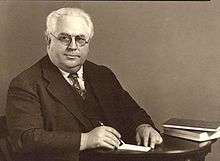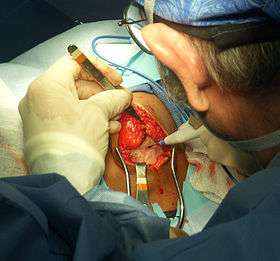William T. Bovie
| William T. Bovie | |
|---|---|
 | |
| Born |
September 11, 1882 Augusta, Michigan |
| Died |
January 1, 1958 (aged 75) Fairfield, Maine |
| Fields | Biophysics |
| Institutions |
Harvard University Northwestern University Jackson Laboratory |
| Known for | Bovie electrocautery device |
William T. Bovie (September 11, 1882 – January 1, 1958) was an American scientist and inventor. He is credited with conceptualizing the field of biophysics and with inventing a modern medical device known as the Bovie electrosurgical generator. Bovie taught or conducted research at Harvard University, Northwestern University, Jackson Laboratory and Colby College.
Biography
Bovie was son of Henrietta Barnes Bovie and physician William Bovie. He worked as a stenographer while he saved money to attend college. Bovie went to Albion College before transferring to the University of Michigan to finish his undergraduate degree. He earned a master's degree from the University of Missouri. While in Missouri, he met his future wife, Martha Adams. The couple had one son. In 1914, he completed a Ph.D. in plant physiology from Harvard University.[1]
Before working with electrocautery, Bovie conducted research with radium at Harvard. Later in life, he suffered from painful hand problems as a result of the radium exposure during this period. Bovie's work was not the first with electricity in surgery. It was known, for example, that electric current above certain frequencies could cut tissue without inducing muscular contraction. Bovie used such knowledge to create his electrosurgical device and he first employed it in neurosurgical cases with Harvey Cushing, known as the father of neurosurgery.[2] Bleeding had been the significant obstacle in neurosurgery until Bovie and Cushing began to employ the device in 1926.[3]

Bovie's device allowed Cushing to reexplore operations in patients with brain masses that had been declared inoperable. While the device revolutionized surgery, there were occasional technical problems. Cushing recalled an instance in which the current from Bovie's device short circuited through a retractor. Electricity traveled up Cushing's arm and to his headlight, an experience that Cushing described as "unpleasant to say the least."[2] In another case, the Bovie device briefly ignited ether gas that was being given to a patient during surgery.[2]
Known as the founder of the field of biophysics,[4] Bovie chaired the new biophysics department at Northwestern University after his relatively brief association with Cushing.[2] He received the John Scott Medal in 1928 for his development of the electrosurgical device.[5] He was made a Fellow of the American Academy of Arts and Sciences.[6]
Bovie later worked at Jackson Laboratory in Bar Harbor, Maine, and at Colby College. As he was not motivated by financial gain, Bovie had sold the patent rights to his electrosurgical device to a manufacturer for one U.S. dollar. He was relatively poor in his later life. His longtime struggle with obesity had led to health problems, including diabetes and arthritis. He died on January 1, 1958.[2]
References
- ↑ Hannan, Caryn (1998). Michigan Biographical Dictionary: A-I. North American Book Dist LLC. pp. 87–89. ISBN 978-0-403-09801-9. Retrieved March 28, 2015.
- 1 2 3 4 5 Carter, Preston L. (2013). "The life and legacy of William T. Bovie" (PDF). The American Journal of Surgery. 205: 488–491. doi:10.1016/j.amjsurg.2012.12.005. Retrieved March 28, 2015.
- ↑ Voorhees, Jennifer R.; Cohen-Gadol, Aaron A.; Laws, Edward R.; Spencer, Dennis D. (2005). "Battling blood loss in neurosurgery: Harvey Cushing's embrace of electrosurgery". Journal of Neurosurgery. 102 (4): 745–752. doi:10.3171/jns.2005.102.4.0745. Retrieved March 28, 2015.
- ↑ Goldfarb, Walter (2009). "Harvey Cushing and the New England Surgical Society". JAMA Surgery. 144 (5): 476–479. doi:10.1001/archsurg.2009.38. Retrieved March 28, 2015.
- ↑ "John Scott Award". University of Pennsylvania. Retrieved March 28, 2015.
- ↑ "Records of meetings". Proceedings of the American Academy of Arts and Sciences. 56: 377. 1921. Retrieved March 28, 2015.